 chapter 6
chapter 6
Time Management
There Are Not Enough Hours in a Day!
You have been invited by the vice president of sales to teach a half-day session about managing stress at an internal annual meeting for the salespeople.
What They Say—The Situation
![]()
| You: | What has happened that triggered this call? |
| Executive: | Well, the good news is that our sales are way up. The bad news is that we've had some issues this year. About 10 percent of our salespeople have been fired for submitting overstated numbers and faked orders. This stuff was reported in the newspaper, so we have two things putting pressure on our existing sales staff: concerned customers and fewer salespeople. The sales staff are selling pretty well and our sales are up, but I can tell the people are starting to get really burned out. It's going to be another 6 months before we're able to get additional sales staff, so I'm hoping you can help me figure out how to help the staff we have. |
| You: | So, it sounds like they are still selling, even though the salespeople might be feeling more pressure. Have you notice any other problems from this stress? |
| Executive: | Yes, about 5 percent of our sales staff has left for other jobs, and this number is growing. That just puts more pressure on the salespeople still here. In addition, we are getting a lot more complaints from the installers and the customers that the orders were not what they wanted or were incomplete. |
| You: | So, the salespeople are considering leaving and because of their stress might not be listening as well to the customers or attending to detail like they should. Is that what you've seen? |
| Executive: | Yes, that's it! I'm worried that it's only a matter of time before our sales are affected. With all the negative attention in the press, the last thing we need is a noticeable drop in sales. |
 What You Hear
What You Hear
Your conversation with the client and your research has brought you to the conclusions listed in table 6-1.
Table 6-1. Logical conclusions.
| What the Client Says | What You Hear |
| Our sales are great, but our sales staff are in a mess. | This is a critical tipping point. There's evidence that if something isn't done quickly, the sales and retention will drop. |
| The salespeople have a right to be burned out. They have little help, but have to keep selling even under challenging circumstances. | Perception is reality. It's possible that the sales staff are assuming that the customers will be hesitant but that the customers aren't really paying attention to the negative press. |
| There will not be any additional staff to help for 6 months. | The sales staff must learn to prioritize their efforts. They must learn to use their time and efforts more expeditiously. |
You build agreement with the executive that there are two goals to this initiative. First, the current growth in sales must be maintained by working with the sales staff to define and help them self-diagnose their current attitudes and beliefs. Second, by teaching the salespeople ways to manage their burnout and stress, the training should reduce and avoid turnover among sales staff. The salespeople and their managers will all partake in this training intervention.
 What You Do
What You Do
Begin where all good performance solutions begin—with asking the right questions. Your training and performance instincts have already given you some good guidance, but as is true for all successful interventions, you first have to figure out what's really behind what is said. Here are some questions that need to be asked before the solution can be proposed:
![]() What is creating the situation that the sales staff cannot be replaced for 6 months?
What is creating the situation that the sales staff cannot be replaced for 6 months?
![]() What are the behaviors and symptoms that point to staff burnout?
What are the behaviors and symptoms that point to staff burnout?
![]() How many customers have stopped doing business with the company?
How many customers have stopped doing business with the company?
![]() What is the seniority of the sales staff?
What is the seniority of the sales staff?
![]() What was the retention rate before the firings began?
What was the retention rate before the firings began?
Results of Questions
In this example, you have learned from asking these questions that:
![]() The sales managers will best be able to describe the changes in behavior that they have seen. They will also be able to share exit interview information about the staff that have taken other jobs.
The sales managers will best be able to describe the changes in behavior that they have seen. They will also be able to share exit interview information about the staff that have taken other jobs.
![]() There are customers who have been very loyal and who would be willing to talk with you about the current state of the business.
There are customers who have been very loyal and who would be willing to talk with you about the current state of the business.
![]() The salespeople are on full commission, so they are always quite motivated to sell. On a whole, they love to compete with each other.
The salespeople are on full commission, so they are always quite motivated to sell. On a whole, they love to compete with each other.
![]() The company has been pretty secretive about the problems with the staff who were terminated because of looming litigation. The sales staff has never really been told what happened, and rumors are rampant.
The company has been pretty secretive about the problems with the staff who were terminated because of looming litigation. The sales staff has never really been told what happened, and rumors are rampant.
Your Triage Intervention

The executive has presented you two constraints within which your intervention must function. First, the salespeople have an annual sales meeting planned in a month. You will have 1 day to work with them at the conference. The second constraint is that the interviews with the sales managers and customers will have to be completed in the next 2 weeks to meet the deadline for the conference. Keeping these constraints in mind, you have proposed to the executive the plan laid out in figure 6-1, and she has accepted.
![]() Prerequisite 1-hour individual customer interviews (activity 6-1) and half-day interviews with the sales managers (activity 6-2). Purpose: Learn about the customers’ perspective and establish behavioral evidence.
Prerequisite 1-hour individual customer interviews (activity 6-1) and half-day interviews with the sales managers (activity 6-2). Purpose: Learn about the customers’ perspective and establish behavioral evidence.

![]() A 1-day workshop at the sales conference including a mini-assessment (activity 6-3), interactions for managing transitions (activities 6-4 and 6-5), managing stress (activity 6-6), setting priorities (activities 6-7 and 6-8), and dealing with burnout (activity 6-9). Purpose: Help people become consciously aware of how they are feeling and provide techniques to help them continue to self-diagnose and adjust.
A 1-day workshop at the sales conference including a mini-assessment (activity 6-3), interactions for managing transitions (activities 6-4 and 6-5), managing stress (activity 6-6), setting priorities (activities 6-7 and 6-8), and dealing with burnout (activity 6-9). Purpose: Help people become consciously aware of how they are feeling and provide techniques to help them continue to self-diagnose and adjust.

You only have 4 weeks to build the initial executive session, then 4 weeks after that to roll out the initial class for the first participants. More details about the solution are outlined in the following sections.
1. Prerequisite Interviews With the Customers and Sales Managers
To be able to share data with the participants at the start of the 1-day workshop, you have decided to interview key sales managers and key customers. You are going to meet with the sales managers together for a half-day group interview, and you are going to talk with the customers over the phone one-on-one for up to an hour.
Figure 6-1. Your time management intervention.
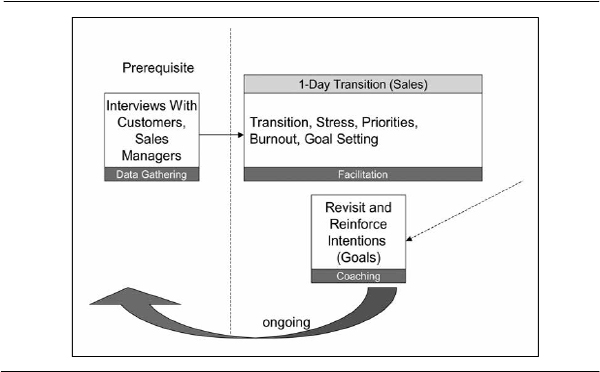
Starting with the customer allows you to share the data with the sales managers during your interviews with them. When interviewing the customer, you must be careful not to lead the customer into believing things are worse than they are. Good questions to ask during the interview are presented in activity 6-1. Collect this data based on customer responses, and summarize it into brief reports that you will share with the entire group.
When you meet with the sales managers, use the questions in activity 6-2 to guide your discussion. You can also ask the same questions you asked during your requirements gathering. Collect this data and summarize it on flipcharts. Ask the sales managers to prepare a presentation for the sales staff at the next meeting around the lessons they've learned by discussing these questions.
2. 1-Day Workshop at the Sales Convention
As people come into the session, ask them to fill out a mini-assessment (activity 6-3) that consists of just two questions:
![]() How good is our service to our customers?
How good is our service to our customers?
![]() How satisfied are you with your job?
How satisfied are you with your job?
Each response is evaluated on a scale from 1 to 10, one being the lowest. Quickly ask someone to summarize these responses so you can share the results during the session. Then, as an opener, ask the sponsor to introduce you and set the stage for managing transitions. After you are introduced, welcome everyone and ask them to do the first transitions activity.
Transitions: Four Quadrants. This quick, energizing exercise (activity 6-4) will help people see that their own expectations cause at least part of the stress in their jobs.
Transitions: Bridges’ Worksheet. This reflective activity (activity 6-5) leads people through the William Bridges’ transition model. They will be asked to figure out where they are in their current transition. They will share their results and build a model to depict where they are as an organization.
Managing Stress: Worksheet. The brief worksheet (activity 6-6) will help people see where their own stress is coming from. This will not be shared, unless they opt to release the information.
Managing Stress: Determining Priorities. The reflective exercises for activity 6-7 can help participants figure out what is really important in their lives.
Managing Stress: Pie Chart. Activity 6-8 can help people focus on what is important to them by breaking their day down into time segments to see if the time spent aligns with their priorities.
Dealing With Burnout: Intentions Worksheet. Activity 6-9 is an individual reflective activity. Given the priorities established in the pie chart worksheet, each person writes intentions or goals for where he or she wants to be.
What You Build

The plan is approved, and now it is time for you to design the measurable learning objectives for each part of the proposed solution, determine facilitation requirements, and create course materials.
Prerequisite Interviews With the Customers and Sales Managers
To be able to share data with the participants at the start of the 1-day workshop, you have decided to interview key sales managers and key customers. You are going to meet with the sales managers together for a half-day group interview, and you are going to talk with the customers over the phone one-on-one for up to 1 hour. You use activities 6-1 and 6-2 as sources of questions.
Learning Objectives. The purpose of these interviews is to gather data about how the sales staff is performing from their bosses (sales managers) and their customers.
Required Equipment and Supplies. All you need for this phase in the initiative is note paper for your notes on the phone with the customers and flipchart paper for the session with the sales managers.
Step-by-Step. Follow these steps to implement this activity:
1. Start with the customer (allowing you to share this data with the sales managers later). When interviewing the customer, you must be careful not to lead the customer to believe things are bad if he or she doesn't already. Use the questions in the interview sample provided as activity 6-1.
2. Collect the customer response data and summarize it in brief reports that you share with the entire group.
3. When you meet with the sales managers, begin a discussion around the interview questions in activity 6-2, which includes questions you asked during your requirements gathering.
4. Collect this data and summarize it on flipcharts. Ask the sales managers to prepare a presentation for the sales staff at the next meeting around the lessons they've learned by discussing these questions.
One-Day Workshop
Learning Objectives. After completing the 1-day session, participants will be able to do the following:
![]() Define the current state of customer service through data from customers and sales managers in the same way.
Define the current state of customer service through data from customers and sales managers in the same way.
![]() Clarify where they are on the managing transitions model based on the work of William Bridges.
Clarify where they are on the managing transitions model based on the work of William Bridges.
![]() Identify what is important to them and spend their time accordingly.
Identify what is important to them and spend their time accordingly.
![]() Set goals for improving the future and lessening their feelings of burnout.
Set goals for improving the future and lessening their feelings of burnout.
Required Equipment and Supplies. Prior to the workshop, assemble the following items:
![]() initial mini-assessment (activity 6-3)
initial mini-assessment (activity 6-3)
![]() flipchart paper and markers
flipchart paper and markers
![]() blank paper for activities.
blank paper for activities.
Step-by-Step.
1. As people come into the session, ask them to fill out the mini-assessment. Have someone to summarize these results quickly so you can share the results during the open session.
2. To open the session, ask the sponsor to introduce you and set the stage for managing transitions. After you are introduced, welcome all the participants and ask them to do this first activity.
Transitions: Four Quadrants. Pass out the four-quadrant worksheet (activity 6-4). Make sure everyone has something to write with. Begin by giving them 30 seconds to draw the first time in quadrant 1. Continue giving people 30 seconds to draw the other quadrants with these restrictions:
![]() Quadrant 2: Draw with your nondominant hand.
Quadrant 2: Draw with your nondominant hand.
![]() Quadrant 3: Draw with your dominant hand, but with eyes closed.
Quadrant 3: Draw with your dominant hand, but with eyes closed.
![]() Quadrant 4: Draw with your nondominant hand with eyes closed.
Quadrant 4: Draw with your nondominant hand with eyes closed.
As the exercise progresses, you will notice the participants’ behavior changing. In the beginning, participants will keep to themselves, quietly and seriously drawing, not sharing at all. By quadrant 4, this will have become a very social activity with participants laughing at themselves and sharing their drawings.
Debrief by pointing out how their behavior changed and asking them why that happened? You want them to self-discover that when people apply the words “should” and “could” to themselves (for example, “I should be able to draw”), they add to their own stress. In the last quadrant, people collaborated because they had no expectations of how their drawings would turn out.
At this time, pass out the results from the customer interviews. Discuss how thinking “should” and “could” might be hindering service to the customers and restricting sales. Follow this with the sales managers’ reports on their session. Lead a discussion on why people are acting the way they are using the four-quadrant activity as an illustration.
Managing Transitions. Pass out the worksheet on managing transitions (activity 6-5). Go over the model with the group and share examples of endings, the neutral zone, and new beginnings. For more information, read the book Managing Transitions by William Bridges. Give the participants time to quietly fill out the worksheet.
Share answers in the small teams of three to five participants. Ask each team to pick a person to share a summary of the rest of the group's responses.
Managing Stress. Through a series of worksheets, this part of the session will help each person measure his or her own stress as well as reveal what is important to him or her (as reflected in his or her lifestyle and time management). Activities 6-6, 6-7, and 6-8 contain all the worksheets you need to get through the stress management portion of the 1-day session. Pass out the worksheets and give the participants permission to go work on this activity somewhere else if being alone would help them think. Give them at least 30 minutes to compose their answers.
When people return, debrief around what they have learned by asking people to pair up and share their responses. This will take another 30 minutes. When this is complete, talk about the experience as a group:
![]() What surprised you about your answers?
What surprised you about your answers?
![]() What did not surprise you about your answers?
What did not surprise you about your answers?
![]() On a scale of 1 to 10 (high), what is your current stress level?
On a scale of 1 to 10 (high), what is your current stress level?
![]() What are some ways of reducing your stress that are not under your control?
What are some ways of reducing your stress that are not under your control?
![]() What are some ways of reducing your stress that are under your control?
What are some ways of reducing your stress that are under your control?
Dealing With Burnout: Intentions Worksheet. Using the intentions worksheet (activity 6-9), ask participants again to go off by themselves and consider their goals based on their stress and time assessments. Encourage them to think through the entire worksheet to keep their lives in balance.
Tips. Try these ideas to make the workshop run smoothly:
![]() Remember that this is a highly individual, reflective day. This is not the strength of most salespeople. Give them plenty of time to share their results but in a way that keeps them safe (small groups or one-on-one). To process effectively, they will have to process socially.
Remember that this is a highly individual, reflective day. This is not the strength of most salespeople. Give them plenty of time to share their results but in a way that keeps them safe (small groups or one-on-one). To process effectively, they will have to process socially.
![]() Devoting too much time to these activities is better than not enough. Do not rush these reflections.
Devoting too much time to these activities is better than not enough. Do not rush these reflections.
![]() Be sure that the instructions are clear when you send people out to reflect, especially about what time you want them to return.
Be sure that the instructions are clear when you send people out to reflect, especially about what time you want them to return.
Results. If at first people are reluctant to share their responses with the group (as this information is very personal in many cases), you must be persistent. Eventually a few people will share their observations, and then everyone becomes engaged. People are scared—scared of being fired, scared that the company is going under, and scared that they will not be able to get another job.
By moving to the intentions stage, people are given the power to control a little bit of their destiny. You have emphasized that no one can control change, but everyone can control how he or she reacts to it.
Customizing Tips. If you don't have as much time, consider assigning the worksheets as a prerequisite. Be prepared for what you will do when people show up without the worksheets filled out.
If you do not have access to the customer, consider using people who work directly with the customer like implementation teams or call center personnel.
Measuring Your Success
To measure ongoing improvement, consider the following:
![]() Encourage the sales managers to review their staff members’ intentions, and revisit their progress at least every 30 days. To build even more trust, have the sales managers share their own intentions with their team.
Encourage the sales managers to review their staff members’ intentions, and revisit their progress at least every 30 days. To build even more trust, have the sales managers share their own intentions with their team.
![]() Consider continuing customer interviews yearly to check on overall service perception. Another alternative to ensure buy-in is to have the sales managers do the customer calls periodically and share the results with not only the other sales managers, but also their teams.
Consider continuing customer interviews yearly to check on overall service perception. Another alternative to ensure buy-in is to have the sales managers do the customer calls periodically and share the results with not only the other sales managers, but also their teams.
Debrief
Change is not only a constant today, it is an accelerating constant. Many teams benefit from having better models to understand their own and others’ abilities to thrive during change. This sales organization has never had the opportunity to grieve for the old ways or see the possibilities in the new ways. The staff have been thrown into a place that is uncomfortable, and each person is struggling.
Notice in this story, that if you didn't listen well to the situation, you might have assumed that these folks need sales training. Turns out, it isn't the sales technique that is the biggest problem, it is the salespeople's lack of discipline in applying what they already know works well. They aren't able to modify their own strengths because they are very busy fighting change on a psychological level.
Also, notice that when an organization places increased pressure on salespeople, raising the bar each pay cycle with no new customers or product, the team will eventually give up. It is not uncommon for sales organizations to go through ups and downs due to this common corporate mistake. Help salespeople by giving them new things to challenge them instead of penalizing them for doing well by asking for more.
In the next chapter, the organization is struggling with a national change—the need to audit and prove compliance to corporate and federal policies. In days past, it has been enough to show that someone attended a class on a new regulation or rule. Now, under the present regulatory milieu, organizations must also prove that learning occurred and behaviors are being monitored. This is great for the Training Triage Master!

Activity 6-1

Activity 6-2
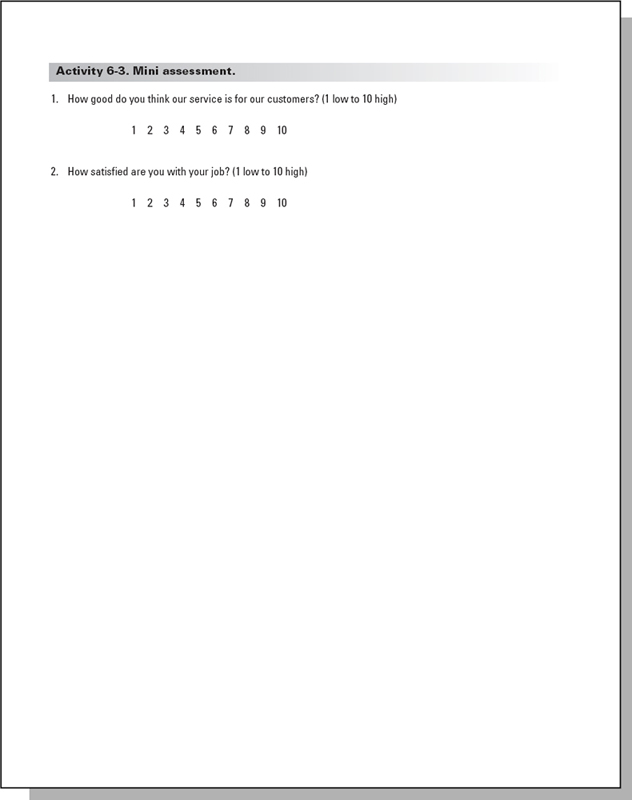
Activity 6-3

Activity 6-4
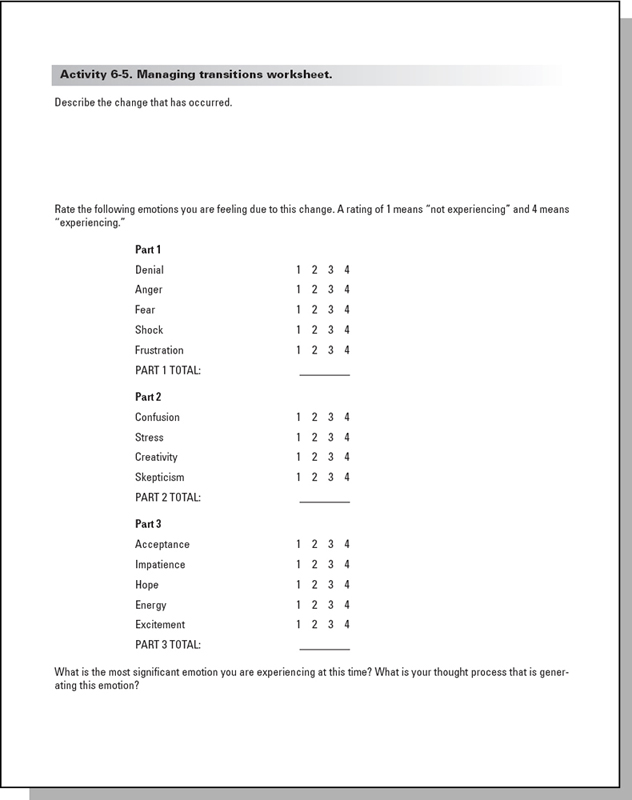
Activity 6-5, page 1
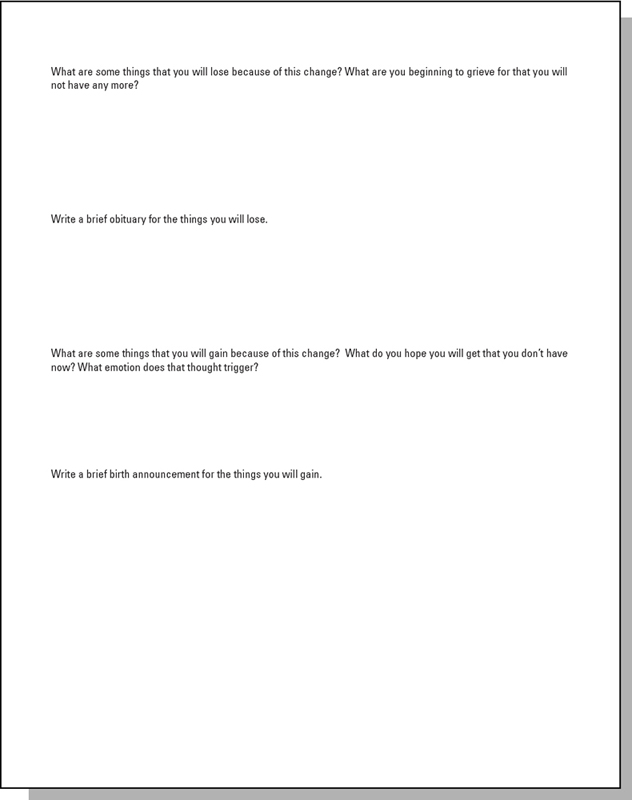
Activity 6-5, page 2
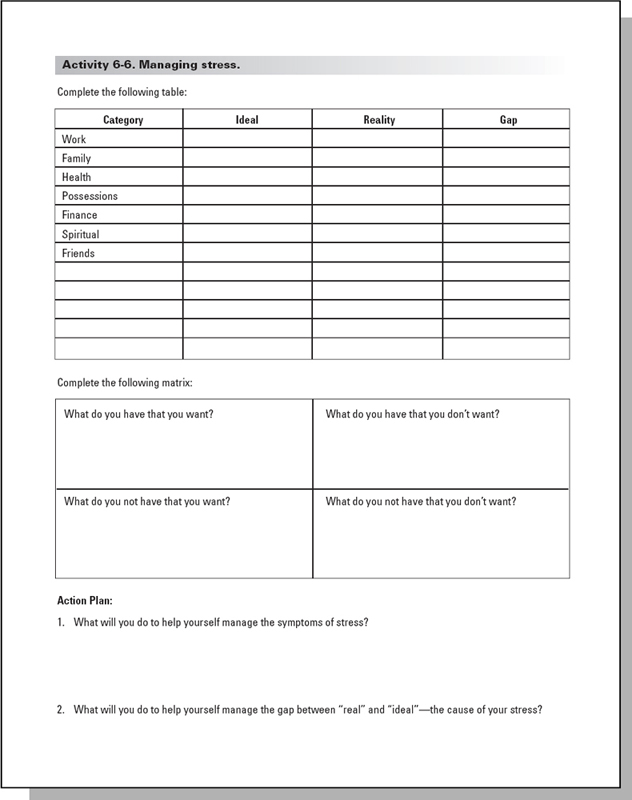
Activity 6-6
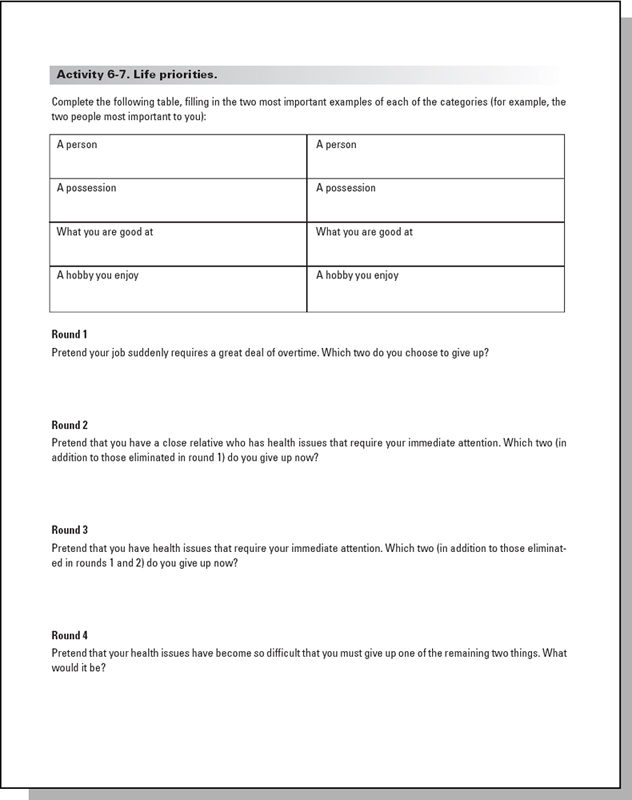
Activity 6-7, page 1

Activity 6-7, page 2

Activity 6-8

Activity 6-9
